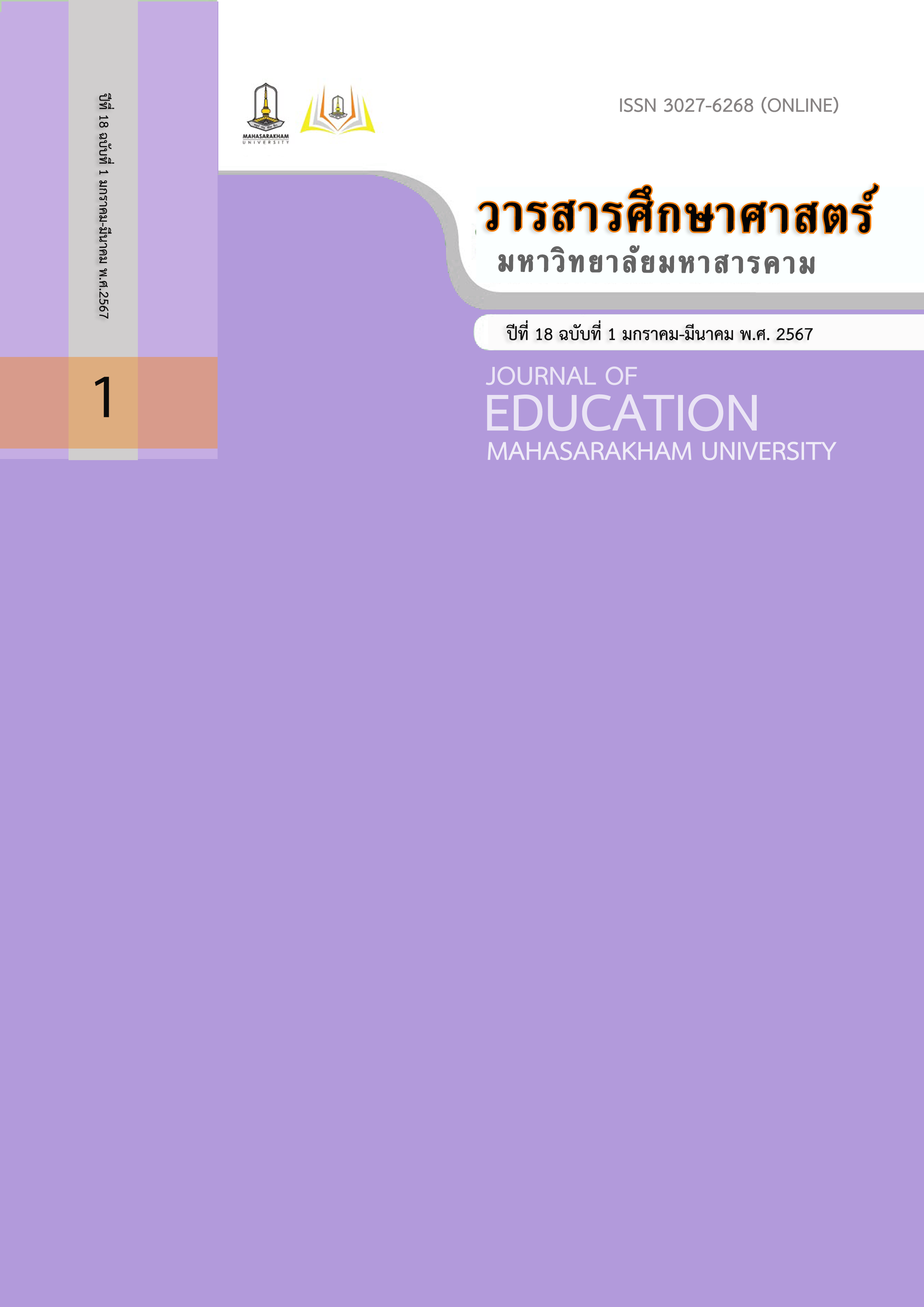Web Developing Digital Media Collaboration with Augmented Reality (AR) for Synectics Instructional to Enhance Creativity
Main Article Content
Abstract
This research aims to: 1) survey the requirement about the Web developing digital media collaboration with Augmented Reality (AR) for Synectics instructional to enhance creativity. 2) develop a website and AR integrated digital media set, 3) measure students' creative thinking through learning via the website and AR integrated digital media set, 4) study the satisfaction of the sample group towards using the website and AR integrated digital media set. The study utilized the following tools: 1) a survey on knowledge and needs related to AR integrated digital media set development, 2) Website and digital media collaborating with Augmented Reality (AR) consists of Website, Electronic book (E-book) and Motion graphics. 3) The Test for Creative Thinking Drawing Production (TCT-DP) developed by Jellen and Urban, 4) an evaluation questionnaire on satisfaction of the sample group towards using the website and AR integrated digital media set. The sample group consisted of 45 second-year undergraduate students from the Department of Educational Communication and Technology, Faculty of Industrial Education and Technology, King Mongkut's University of Technology Thonburi. The participants were selected through simple random sampling method. The study results indicated: 1) There was a significant demand for Augmented Reality technology, with a high level of interest ( =4.48, S.D.=0.78) and a strong preference for digital media formats, with 99.5% for websites, 90.5% for e-books, and 82.5% for motion graphics. 2) The quality of digital media in the form of websites, e-books, and motion graphics, in both content and visual aspects, was rated very high (
=4.85, S.D.=0.22). 3) Post-learning creative thinking scores were significantly higher than pre-learning scores, with statistical significance at the .05 level. 4) Participant satisfaction was at the highest level (
=4.74, S.D.=0.44). In conclusion, the development of a website and AR integrated digital media set for Synectics teaching method proved effective in enhancing creative thinking and received excellent feedback from the participants.
Downloads
Article Details

This work is licensed under a Creative Commons Attribution-NonCommercial-NoDerivatives 4.0 International License.
References
คณิต ดวงหัสดี. (2537). สุขภาพจิตกับความพึงพอใจในงานของข้าราชการตำรวจชั้นประทวนในเขตเมืองและเขตชนบท ของจังหวัดขอนแก่น, วิทยานิพนธ์ศึกษาศาสตร์มหาบัณฑิต,สาขาจิตวิทยาการศึกษา, บัณฑิตวิทยาลัย, มหาวิทยาลัยขอนแก่น.
ธเนศ ศรพรหม. (2562). การพัฒนารูปแบบการเรียนรู้ที่ส่งเสริมความคิดสร้างสรรค์ ภายใต้สภาพแวดล้อมแบบเปิด สำหรับนักศึกษาปริญญาตรี. วารสารบัณฑิตวิทยาลัย พิชญทรรศน์, 14(1).
พรรณภัทร เกษประสิทธิ์. (2563). การจัดกิจกรรมการเรียนรู้ภาษาอังกฤษ โดยใช้เทคนิคซินเนคติกส์ (SYNECTICS) เพื่อเสริมสร้างความคิดสร้างสรรค์ของนักเรียนชั้นมัธยมศึกษาปีที่ 1, วิทยานิพนธ์ปริญญาการศึกษามหาบัณฑิต,สาขาหลักสูตรการสอน, มหาวิทยาลัยพะเยา.
พล พิมพ์โพธิ์. (2561). ผลการจัดการเรียนรู้โดยใช้แนวคิดอรรถฐานร่วมกับรูปแบบการสอนซินเนคติกส์ที่มีต่อความสามารถในการเขียนร้อยกรองเชิงสร้างสรรค์และเจตคติต่อการเขียนร้อยกรองเชิงสร้างสรรค์ ของนักเรียนชั้นมัธยมศึกษาปีที่ 5. วิทยานิพนธ์ปริญญาการศึกษามหาบัณฑิต,สาขาวิทยาการทางการศึกษาและการจัดการเรียนรู้, มหาวิทยาลัยศรีนครินทรวิโรฒ.
พัทธนันทร์ บุตรฉุย. (2559). การพัฒนารูปแบบการแบ่งปันความรู้ออนไลน์โดยใช้แนวคิดเชิงออกแบบร่วมกับเทคนิคการวิเคราะห์อนาคตเพื่อเสริมสร้างความคิดสร้างสรรค์เชิงธุรกิจของนิสิตนักศึกษาระดับปริญญาบัณฑิตสาขาการจัดการ. วิทยานิพนธ์ครุศาสตรดุษฎีบัณฑิต,สาขาเทคโนโลยีและสื่อสารการศึกษา, ครุศาสตร์, จุฬาลงกรณ์มหาวิทยาลัย.
ฟิสิกส์ ฌอณ บัวกนก และไพศาล สุวรรณน้อย. (2554). การพัฒนารูปแบบกิจกรรมซินเน็คติกส์ในการเรียนการสอนบนเว็บวิชากลยุทธ์การสร้างสรรค์โฆษณา เพื่อพัฒนาความคิดสร้างสรรค์ของนักศึกษาระดับปริญญาบัณฑิต , วารสารวิจัยมหาวิทยาลัยขอนแก่น, 11(3).
Bagherpur, M., Vakili, K., Emami, T. & Eimery, S. (2021). The Impact of Training by Augmented Reality Technology on Creative Thinking and English-Language Learning Motivation of Students. International Journal of Early Childhood Special Education, 13(2), 1230-1237.
Dilekçi, A. and Karatay, H. (2023). The effects of the 21st century skills curriculum on the development of students’ creative thinking skills. Thinking Skills and Creativity. 47.
Jellen, H. G., & Urban, K. K. (1986). The TCT-DP (Test for Creative Thinking-Drawing Production): An instrument that can be applied to most age and ability groups. Creative Child & Adult Quarterly, 11(3), 138–155.
Klaus, K. & Urban, K. K. (2005). Assessing creativity: The Test for Creative Thinking - Drawing Production (TCT-DP). International Education Journal, 2005, 6(2), 272-280.
Muhammad, M. (2022). Review of Trends in Learning Media of Augmented Reality Integrated with STEM Approach to Improve Students' Creative Thinking Skill, The 11th National Physics Seminar (SNF 2022): Journal of Physics: Conference Series, 2377.
Oncu, E., C. (2016). Improved creative thinkers in a class: A model of activity based tasks for improving university students creative thinking abilities, Educational Research and Reviews, 11(8), 517-522.
Suratno, Komaria, N. , Yushardi, Dafik , Wicaksono, I. (2019).The Effect of Using Synectics Model on Creative Thinking and Metacognition Skills of Junior High School Students. International Journal of Instruction . 12(3).
Wei, X., Weng, D., Liu, Y., Wang, Y. (2015). Teaching based on augmented reality for a technical creative design course. Computers & Education. 81, 221-234.


